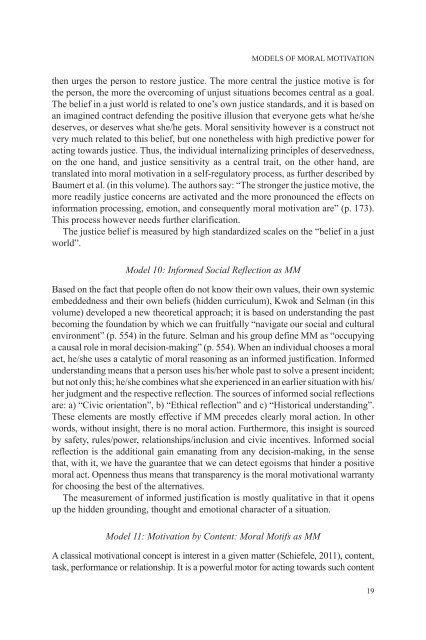Handbook of moral motivation: Theories, models ... - Sense Publishers
Handbook of moral motivation: Theories, models ... - Sense Publishers
Handbook of moral motivation: Theories, models ... - Sense Publishers
- No tags were found...
You also want an ePaper? Increase the reach of your titles
YUMPU automatically turns print PDFs into web optimized ePapers that Google loves.
MODELS OF MORAL MOTIVATIONthen urges the person to restore justice. The more central the justice motive is forthe person, the more the overcoming <strong>of</strong> unjust situations becomes central as a goal.The belief in a just world is related to one’s own justice standards, and it is based onan imagined contract defending the positive illusion that everyone gets what he/shedeserves, or deserves what she/he gets. Moral sensitivity however is a construct notvery much related to this belief, but one nonetheless with high predictive power foracting towards justice. Thus, the individual internalizing principles <strong>of</strong> deservedness,on the one hand, and justice sensitivity as a central trait, on the other hand, aretranslated into <strong>moral</strong> <strong>motivation</strong> in a self-regulatory process, as further described byBaumert et al. (in this volume). The authors say: “The stronger the justice motive, themore readily justice concerns are activated and the more pronounced the effects oninformation processing, emotion, and consequently <strong>moral</strong> <strong>motivation</strong> are” (p. 173).This process however needs further clarification.The justice belief is measured by high standardized scales on the “belief in a justworld”.Model 10: Informed Social Reflection as MMBased on the fact that people <strong>of</strong>ten do not know their own values, their own systemicembeddedness and their own beliefs (hidden curriculum), Kwok and Selman (in thisvolume) developed a new theoretical approach; it is based on understanding the pastbecoming the foundation by which we can fruitfully “navigate our social and culturalenvironment” (p. 554) in the future. Selman and his group define MM as “occupyinga causal role in <strong>moral</strong> decision-making” (p. 554). When an individual chooses a <strong>moral</strong>act, he/she uses a catalytic <strong>of</strong> <strong>moral</strong> reasoning as an informed justification. Informedunderstanding means that a person uses his/her whole past to solve a present incident;but not only this; he/she combines what she experienced in an earlier situation with his/her judgment and the respective reflection. The sources <strong>of</strong> informed social reflectionsare: a) “Civic orientation”, b) “Ethical reflection” and c) “Historical understanding”.These elements are mostly effective if MM precedes clearly <strong>moral</strong> action. In otherwords, without insight, there is no <strong>moral</strong> action. Furthermore, this insight is sourcedby safety, rules/power, relationships/inclusion and civic incentives. Informed socialreflection is the additional gain emanating from any decision-making, in the sensethat, with it, we have the guarantee that we can detect egoisms that hinder a positive<strong>moral</strong> act. Openness thus means that transparency is the <strong>moral</strong> <strong>motivation</strong>al warrantyfor choosing the best <strong>of</strong> the alternatives.The measurement <strong>of</strong> informed justification is mostly qualitative in that it opensup the hidden grounding, thought and emotional character <strong>of</strong> a situation.Model 11: Motivation by Content: Moral Motifs as MMA classical <strong>motivation</strong>al concept is interest in a given matter (Schiefele, 2011), content,task, performance or relationship. It is a powerful motor for acting towards such content19














